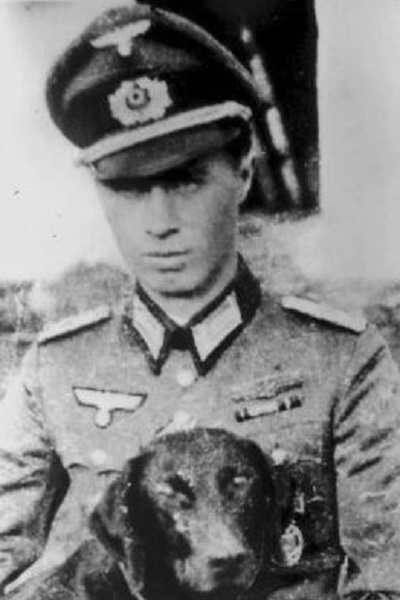Graf, Aloysius Anton "Alois"
- Date of birth:
- September 14th, 1908 (Börrstadt/Palatinate, Germany)
- Date of death:
- April 8th, 1945 (Moravská Ostrava/Moravia, Czechoslovakia)
- Nationality:
- German (1933-1945, Third Reich)
Biography
Alois Graf was posthumously promoted to Oberst.
Do you have more information about this person? Inform us!
- Period:
- Second World War (1939-1945)
- Rank:
- Oberstleutnant (Lieutenant-colonel)
- Unit:
- Kommandeur, Grenadier-Regiment 1082, 544. Volksgrenadier-Division, Heer
- Awarded on:
- April 30th, 1945
“On the 10.03.1945, following a 1 1/4 hour artillery drumfire, the enemy launched a major attack against the Division’s frontline (located south of Schwarzwasser) with 2 of their own divisions, elements of a third and a tank brigade (comprising about 30 tanks). By now the Division had been badly depleted by the previous fighting.
Despite sustaining heavy losses of its own, the middle Regiment (Grenadier-Regiment 1082) was able to initially contain the enemy attack thanks to the personal intervention of its battle-hardened commanding officer, Oberstleutnant Graf.
However in the sector of the right Regiment the enemy was able to defeat the I./Grenadier-Regiment 1084 with 1 regiment and 10-12 tanks of their own. The Bataillon commander became a casualty along with 3 company commanders. Considerable elements of the unit became encircled and eventually overrun after their ammunition ran out, and the remainder of the Bataillon was shattered. With this the Division’s frontline was torn apart, and the single road that led to the Vistula bridge at Draschendorf was opened for the enemy. They quickly exploited this favourable outcome, and they immediately sent in infantry columns and tanks to exploit the breach.
In this emergent crisis situation, Graf was fully aware of the danger that would result for his Division if this enemy penetration became a full breakthrough. Since no reserves were available, and since he had temporarily lost contact with the Division, he decided to create a blocking front behind the enemy tanks that had broken through east of Draschendorf. This front extended as far as the pool north of Ochab, and he manned it with some of his own hastily assembled regimental heavy weapons combined with his regimental staff and whatever stragglers from the smashed I./Grenadier-Regiment 1084 he could find.
By further weakening the sector of his own Regiment, and by personally intervening in the close combat at the most dangerous points of the fighting, Graf was able to gradually narrow the extant frontline gap despite the presence of ongoing enemy attacks. In this time he repeatedly led small parties of men in counterthrusts to throw back enemy advances. Ultimately, following close combat that lasted the entire day, he managed to establish a continuous (albeit tenuous) frontline. Thanks to this it was possible for newly arrived divisional reserves to slowly strengthen this frontline, and this proved enough to stop all subsequent enemy attacks during that same evening and in the following days.
Graf’s personal decision to create a new defensive front and extend it as far as the neighbouring unit prevented the enemy from achieving a breakthrough here, a feat which would not have been possible without his personal courage and resilience in this crisis situation. With this the Soviets were unable to capture the important Vistula bridges at Draschendorf and Ochab, which were of vital operational importance to them. In the following days this costly defensive success would prove decisive for not only the Division, but also the entire conduct of combat in the area.
Graf thus has a major share in the official recognition that the Reichsführer-SS extended to the Division for its accomplishments in this round of fighting.”
To this was added an insightful endorsement from the commander of the LIX. Armee-Korps…
“The recommendation is warmly endorsed. Oberstleutnant Graf’s personal actions in this fighting were crucial for the successful defensive effort on the right wing of the Korps’ frontline. This in turn prevented the enemy from breaking through in the direction of the Moravian industrial area.”
Awarded posthumously.
- Period:
- Second World War (1939-1945)
- Awarded on:
- October 27th, 1943
- Period:
- Second World War (1939-1945)
- Rank:
- Major
- Unit:
- Aufklärungs-Abteilung 7, 7. Infanterie-Division, Heer
- Awarded on:
- October 5th, 1943
- Period:
- Second World War (1939-1945)
- Awarded on:
- August 1st, 1942
- Period:
- Second World War (1939-1945)
- Rank:
- Rittmeister
- Unit:
- Aufklärungs-Abteilung 7, 7. Infanterie-Division, Heer
- Awarded on:
- December 26th, 1941
- Period:
- Second World War (1939-1945)
- Awarded on:
- November 26th, 1940
- Period:
- Second World War (1939-1945)
- Awarded on:
- May 29th, 1940
- Period:
- Second World War (1939-1945)
- Awarded on:
- October 2nd, 1939
Sources
- Photo 1: Known to STIWOT
- - FELLGIEBEL, W.P., Elite of theThird Reich, Helion & Company Limited, Solihull, 2003.
- PATZWALL, K. & SCHERZER, V., Das Deutsche Kreuz 1941-1945, Verlag Klaus D. Patzwall, Norderstedt, 2001.
- SCHEIBERT, H., Die Träger der Ehrenblattspange des Heeres und der Waffen-SS/ Die Träger der Ehrentaffelspange etc., Podzun-Pallas Verlag, Friedberg.
- Die Ordensträger der Deutschen Wehrmacht (CD), VMD-Verlag GmbH, Osnabrück, 2002
- Axis History Forum via Awardholders / unit
- Alois Graf | Gräbersuche-Online










